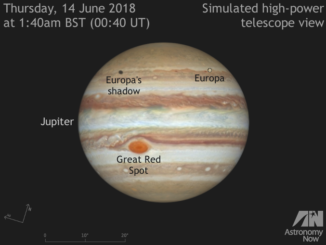
Astronomers using the Atacama Large Millimetre/submillimetre Array – ALMA – have taken the temperature of Europe’s icy moon Europa. Combined with data collected by the Galileo Jupiter orbiter in the 1990s, the researchers have created the first global thermal map of Europa revealing an enigmatic cold spot on the moon’s northern hemisphere.
“These ALMA images are really interesting because they provide the first global map of Europa’s thermal emission,” said Samantha Trumbo, a planetary scientist at the California Institute of Technology and lead author on a paper published in the Astronomical Journal.
“Since Europa is an ocean world with potential geologic activity, its surface temperatures are of great interest because they may constrain the locations and extents of any such activity,” she added.

Evidence indicates the presence of a briny ocean beneath Europa’s icy crust and other observations have suggested the presence of plumes where water ice or vapour may be escaping to space through cracks or fissures in the moon’s young, fractured surface.
But another study, presented at the 50th meeting of the American Astronomical Society’s Division for Planetary Sciences, found no evidence for thermal hot spots where the plumes were detected.
“We searched through the available Galileo thermal data at the locations proposed as the sites of potential plumes,” said Julie Rathbun, a senior scientist at the Planetary Science Institute. “Reanalysis of temperature data from the Galileo mission does not show anything special in the locations where plumes have possibly been observed.”

Saturn’s moon Enceladus features clearly seen plumes of water ice spewing from areas with obvious heat signatures.
“There are no hotspot signatures at either of the (Europa) sites,” Rathbun said. “This is surprising because the Enceladus plumes have a clear thermal signature at their site of origin, so this suggests that either the Europa plumes are very different, or the plumes are only occasional, or that they don’t exist, or that their thermal signature is too small to have been detected by current data.”



